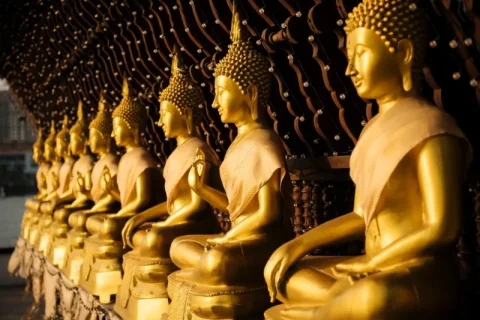
Introduction to the Three Types of Buddhism

Buddhism is one of the world’s major religions, encompassing diverse teachings and practices that have evolved over centuries. Three principal branches—Theravada, Mahayana, and Vajrayana—offer distinct interpretations of the Buddha’s teachings, catering to varied spiritual aspirations and cultural contexts.
Theravada: The Teaching of the Elders
Originating from the teachings preserved in the Pali Canon, Theravada Buddhism is known as the “Teaching of the Elders.” It emphasizes the historical continuity of the Buddha’s teachings, focusing on individual effort toward enlightenment through meditation, ethical conduct, and monastic discipline. Theravada is predominant in countries such as Sri Lanka, Thailand, Myanmar, and Cambodia, where monastic communities play a central role in preserving and propagating Buddhist teachings.
Mahayana: The Great Vehicle
Emerging around the first century BCE in India, Mahayana Buddhism emphasizes the altruistic ideal of the Bodhisattva—a being who postpones their liberation to assist others in achieving enlightenment. Mahayana teachings encompass many philosophical schools and practices, ranging from devotional Pure Land Buddhism to the rigorous meditation practices of Zen (Chan) Buddhism in East Asia. It is widely practiced in China, Japan, Korea, Vietnam, and Tibet, among other regions.
Vajrayana: The Diamond Vehicle
Rooted in Mahayana teachings but distinguished by its emphasis on tantric practices and esoteric rituals, Vajrayana Buddhism developed in India and thrived in Tibet, Bhutan, and Mongolia. Vajrayana practitioners seek to attain enlightenment swiftly within a single lifetime under the guidance of a qualified teacher (guru), employing ritual practices and the invocation of deities. This branch is renowned for its intricate symbolism, use of mandalas, and mantra recitation to transform consciousness and achieve spiritual realization.
Introduction to Theravada Buddhism

Theravada Buddhism, encompasses the Discourses (Suttas), the Monastic Discipline (Vinaya), and the Abhidharma (philosophical texts). Its primary objective is the realization of Nirvana—freedom from suffering and the cycle of rebirth—through adherence to the Noble Eightfold Path. This path comprises Right View, Right Intention, Right Speech, Right Action, Right Livelihood, Right Effort, Right Mindfulness, and Right Concentration.
Focus on Meditation and Renunciation of Desires
Central to Theravada practice is meditation (bhavana), which aims to cultivate mindfulness (sati) and insight (vipassana). Through meditation, practitioners develop clarity of mind and wisdom, deeply understanding the impermanent and interconnected nature of existence. They strive to overcome suffering and attain liberation by renouncing worldly desires and attachments.
Importance of Traditional Monasticism
Theravada places significant emphasis on the monastic sangha as a vehicle for spiritual practice and the propagation of the Dharma. Monks and nuns adhere strictly to the Vinaya, a code of conduct governing their daily lives, promoting simplicity, ethical behavior, and communal harmony. Monastic life provides a structured environment conducive to intensive meditation practice and the study of Buddhist scriptures, ensuring the continuity and dissemination of the Buddha’s teachings across generations.
Introduction to Mahayana Buddhism

Mahayana Buddhism builds upon the foundational teachings of Theravada by introducing the Bodhisattva ideal—a path of altruism and compassion aimed at achieving enlightenment for the benefit of all sentient beings. Mahayana teachings emphasize the interconnectedness of all beings and the cultivation of virtues such as compassion (karuna) and wisdom (prajna).
Cultivation of Mahayana Practices and Compassion
Practitioners of Mahayana Buddhism engage in various practices aimed at developing compassion and wisdom, known as the Six Perfections (paramitas). These include giving (dana), keeping precepts (sila), tolerance (ksanti), diligent practice (virya), meditation (dhyana), and wisdom (prajna). By cultivating these virtues, Bodhisattvas aspire to attain Buddhahood and guide others toward liberation.
Goals and Aspirations of Mahayana Buddhism
Mahayana teachings emphasize the aspiration to attain Buddhahood for oneself and alleviate the suffering of all sentient beings. This altruistic intention permeates Mahayana practices, inspiring practitioners to engage in acts of kindness, generosity, and moral conduct. The ultimate goal is to achieve the highest form of wisdom and compassion, transcending personal liberation to benefit all beings.
Introduction to Vajrayana Buddhism (Tibetan Buddhism)

Vajrayana Buddhism, or Tibetan Buddhism, is a profound spiritual tradition that integrates tantric practices into the Mahayana framework. It emphasizes swift methods (upaya) to attain enlightenment by directly transforming consciousness and recognizing the innate Buddha-nature within all beings.
Importance of the Spiritual Master (Guru)
Central to Vajrayana practice is the relationship between the disciple and the spiritual master (guru). The guru is crucial in transmitting initiations (empowerments) and oral instructions (transmissions) into tantric practices. These empowerments are designed to awaken subtle energies (prana) and facilitate profound spiritual transformations in disciples. The guru-disciple bond is essential for receiving blessings and insights to progress swiftly toward enlightenment.
Dedication of Body, Speech, and Mind
Vajrayana practitioners dedicate their entire being—body, speech, and mind—to the path of Buddha. Through intricate ritual practices and vivid visualizations of deities and mandalas, practitioners seek to purify obscurations and cultivate wisdom. These practices transform the practitioner’s inner world and inspire compassionate actions that benefit all sentient beings.
Mahakala, the Great Black Dharma Protector

Mahakala is a prominent deity in Vajrayana Buddhism, revered as the great black dharma protector. Representing the protective and transformative aspects of enlightenment, Mahakala is often depicted in a wrathful form, symbolizing the swift eradication of obstacles on the spiritual path. Devotion to Mahakala cultivates courage, determination, and spiritual fortitude, shielding practitioners from negative influences and aiding them in overcoming spiritual challenges.
The Six-Syllable Mantra (Om Mani Padme Hum)

A cornerstone of Vajrayana practice is the recitation of mantras, such as the renowned six-syllable mantra “Om Mani Padme Hum.” This mantra invokes enlightened beings’ blessings and compassionate qualities, aligning practitioners with the divine qualities of wisdom and compassion. Mantra recitation, guided by the instructions of the spiritual master, serves as a powerful method to deepen spiritual connection and unify practitioners with the enlightened realm.
In essence, Vajrayana Buddhism offers practitioners expedient methods to achieve enlightenment through the skillful guidance of spiritual masters, dedication to transformative practices, devotion to protective deities like Mahakala, and the profound recitation of sacred mantras. Together, these elements form a holistic approach to spiritual growth and realization in the Tibetan Buddhist tradition.
Conclusion
In conclusion, Theravada, Mahayana, and Vajrayana Buddhism represent distinct paths to spiritual awakening, offering unique teachings, practices, and cultural contexts. Theravada emphasizes individual liberation through meditation and monastic discipline. Mahayana expands this path to include universal compassion and the Bodhisattva ideal, aspiring to benefit all beings. Vajrayana integrates tantric methods and esoteric rituals, aiming for swift enlightenment through the guidance of a spiritual master and the invocation of deities.
Those interested in deepening their understanding of Buddhism and exploring its transformative practices should learn more about Theravada, Mahayana, and Vajrayana through Bodhi Meditation Courses.

